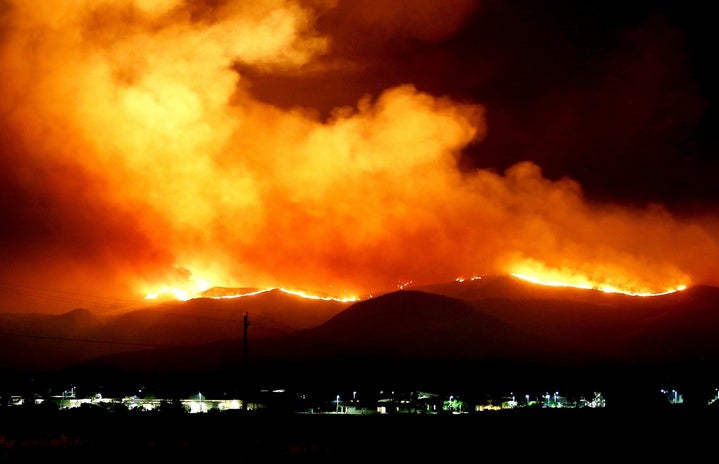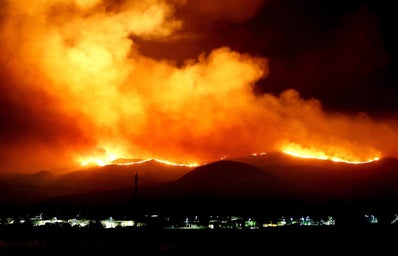On August 22, California Governor Gavin Newsom tweeted an aerial photo of a burning smoke-filled forest mountainside saying, “If you don’t believe in climate change, come to California. This is from today. And it is just a small part of the nearly 600 fires we are battling this week.”
California is currently suffering from one of the worst wildfire seasons in recorded history. In this year alone, wildfires have burned more than 2 million acres of Californian land, setting a state record previously set in 2018. The average number of burned acres in a season is only a little more than 300,000. The current blazes come at a cataclysmic time with both public health and environmental crises compounding one another. This has become an all too familiar headline in recent years, and it continues to get worse. This year’s fires seem to be highlighting the consequences of decades of climate change buildup from unprecedented ranges, heat waves, drought, and poor air quality.
A perfect storm
California’s wildfire season typically runs from May to October, with peak times beginning around late fall. According to the California Department of Forestry and Fire Protection (Cal Fire), the season’s earlier start times and later end dates can be attributed to the changing climate’s effects on temperatures, snow melts, and rainfall amounts. In March, the NY Times reported that California had its driest February on record, one of three months that contributes to half of the state’s total precipitation. Additionally, the winter months were hotter than normal, with reports of spring- and summer-like temperatures across California, stated David Swain, a climate scientist from UCLA. These conditions indicated that the state’s dry soil and moisture parched plants would lead to increased wildfire risk.
While wildfires have been reported since February of this year, the blazes sparked in mid-August caused a major stir. Over 367 wildfires were ignited following a massive dry lightning storm around the San Francisco Bay Area with nearly 11,000 strikes within three days according to Brice Bennet, a spokesperson from Cal Fire. Additionally, the state has seen an extreme heatwave, with areas of Los Angeles Country seeing 121 degrees over the past weekend, numbers that are unimaginable to most Americans. This heat and high offshore winds have contributed to the continued spread and lighting of more waves of flames across the state.
What’s more troubling is that many areas that are burning do not normally do so during this time of year. When managed correctly under normal conditions, fires are a natural part of a balanced and healthy ecosystem. The burning of dead organic matter can clear space and foster growing conditions for new plants as nutrients are recycled back into the soil. Fires can even rid an ecosystem of intolerant invasive species. But because of the conditions made by human activity, today’s flames burn far out of anyone’s control. Coastal forests which tend to hold lots of moisture due to marine weather, are dryer than ever and are being threatened by the blazes.
Far-reaching effects
The wildfires are coming at a time of great peril for Californians. California is still, as of Sept. 9, the state with the highest number of Covid-19 cases. The state relies heavily on prison labor for firefighting, and are struggling to put out teams as California prisons have been hit hard by the pandemic. The economic crisis caused by the pandemic has also challenged California’s firefighting efforts, resulting in budget cutbacks for fire maintenance and prevention actions.
Additionally, the wildfires and coronavirus make it complicated for evacuation and shelters to take place, as increased time indoors and in high densities can enhance a pandemic’s spread among a population.
The wildfires’ smoke plumes are covering the entire west coast and are causing some of the worst air quality in the country. Areas further out west, as far as Texas, also saw smoke coming from the spreading fires. The hazardous smoke causes dangerous conditions for the elderly, young children, and those, especially with pre-existing respiratory conditions. California already suffers from high levels of air pollution, which increases the susceptibility of many of its residents to the smoke’s effects, especially among communities of minorities and those of lower economic status.
The fires also threaten the state’s power grid. The danger of the flames and the high winds that could spread them have resulted in Pacific Gas and Electric (PG&E), California’s largest electric company, in shutting off power to more than 170,000 customers for days.
Hope can’t be lost
Gov. Newsom has expressed in a statement quoted by Politico that he quite literally has ”no patience for climate change deniers. It’s completely inconsistent, that point of view, with the reality on the ground, the facts as we are experiencing.” This comes after facing criticism from President Trump at a rally in August which centered the blame on California and its inability to “clean” their forests and mocking climate change’s role by saying, “‘The environment, the environment,’ but they have massive fires again” (White, 2020).
Climate change is no longer up for debate. It can’t be. The severity of these fires and the range of people and land affected is too great to be ignored and to be politicized. Nature is slapping us in the face to tell us that we are in trouble. Seeing the headlines of devastation should not cause us to accept what’s happening. If anything, these fires should be driving us to find more solutions, push for better climate policies, and listen to science.
Want to help? Here are a few organizations to consider donating to:



